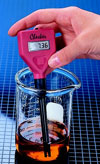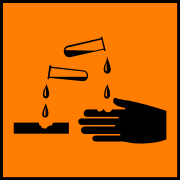|
To differentiate between strong and weak acids and bases, we must test properties that are affected by the hydrogen ion concentration. |
|
General
To tell the difference between strong and weak acids we have to use their properties. The strength of an acid is given by its pH, and this in turn comes from the hydrogen ion concentration. The hydrogen ion concentration depends on two factors:
- The nature of the acid
- The concentration of the acid
It is possible to have acid of any given concentration, so it makes more sense to compare the nature of acids at the same concentration.
We can use any of the following characteristics
- pH
- Energy of neutralisation
- Conductivity
- Rates of reaction
pH measurement
If the concentration of the acid is known, then measurement of the pH using a pH meter (or similar) will tell us whether or not an acid is strong or weak. Stronger acids have lower pH values for the same concentration.
The concentration of any acid, strong or weak, may be found by titration against a standardised base solution. Suitable concentrations for titration are in the range 0.01 - 0.2 mol dm-3.
If we wish to investigate the strength of an acid using pH measurements than the concentration of each acid must be controlled.
|
Example: A 0.1 M solution of hydrochloric acid has a pH value of 1.00 a 0.1 M solution of ethanoic acid has a pH value of 1.87 Comparison of the two pH values shows us that the hydrochloric acid is completely dissociated into ions, whereas the ethanoic acid is only partially dissociated into ions |
The pH meter
These are instruments that rely of the small differences of potential set up between an internal reference (normally a glass electrode) and a solution of hydrogen ions. Before being used the pH meter should be calibrated for the range of pH that it is to be used to measure.
 |
Typical hand-held pH meter operation
|
The pH meter can only be used to differentiate between weak and strong acids providing that the concentrations are known. However, it is convenient to determine the concentration of an acid (or base) by titration.
If two samples of acid, weak and strong, have the same concentration then the solution with the lower pH is the stronger acid..
Neutralisation enthalpy
All strong acids release approximately - 57 kJ/mol of energy on neutralisation with strong base.
This energy release is due to the formation of water molecules from the H+ ions from the acid reacting with the OH- ions from the base.
| H+(aq) + OH-(aq) |
When a weak acid is neutralised some of the energy is needed to dissociate the molecules, making the hydrogen ions available for neutralisation. The result is a value for neutralisation enthalpy lower than - 57 kJ/mol (numerically lower, not more negative!).
|
|
The weak acid is in equilibrium, so as the hydrogen ions are 'mopped up' by the base, the equilibrium shifts to the right hand side to make more hydrogen ions until eventually all of the acid is able to react. This does, however, absorb energy as bonds must be broken to dissociate the weak acid.
|
|
|
|
approx 99%
|
approx 1%
|
In reality, the difference in enthalpy of neutralisation is not large. The value for ethanoic acid is about 55 kJ/mol.
Conductivity
A solution's ability to conduct electricity is conditioned by the concentration of ions it contains. A strong acid has more ions than a weak one, and so it's solution will be a better electrical conductor than a weak acid. The same goes for strong/weak bases.
|
The conductivity (or something related to it) may be measured using a power pack and two graphite electrodes connected to an ammeter. The apparatus is assembled, and current values measured for a given voltage setting. Strong acids pass more current than the weak acids for the same voltage and concentration. The actual conductance of the ionic solution is more difficult to calculate, as it depends on the distance between the electrodes and the overall resistance of the circuit. |
- Strong acids : HCl, HNO3, H2SO4. - good conductors - large value for current passing
- Weak acids : CH3COOH, H2CO3. - poor conductors - low value for current passing
- Strong bases : group 1 hydroxides (ie NaOH etc), or lower group 2 hydroxides Ba(OH)2. - good conductors
- Weak bases : NH3, CH3CH2NH2. - poor conductors
The reason for this is that strong acids (and bases) are 100% dissociated into ions. This means that they provide more ions for conductivity than weak acids (and bases) of comparable concentrations.
|
Example: A 0.1 M solution of hydrochloric acid dissociates 100% into ions.
Therefore the ionic concentration is 0.1 x 2 = 0.2 mol dm-3 Whereas a 0.1 M solution of ethanoic acid has a pH value of 2.87 and only dissociates slightly into ions:
The ionic concentration = 2 x 0.00135 = 0.0027 mol dm-3 The ionic concentration of the strong acid is approximately 74 times that of the weak acid. |
Reaction rates
Similarly, the rate of reaction will reveal the strength of an acid. The rate of a chemical reaction is proportional to the concentration of the reactants. If a suitable reaction of acids is chosen, then the reaction rate should demonstrate which of any pair is a strong and which is a weak acid.
|
The rate of reaction between an acid and a metal carbonate could be investigated. Two acids of equal concentration are added to samples of marble chips of equal mass. The rate of the reaction is studied by plotting the volume of gas evolved against the time taken. The rate at any time is obtained from a graph of volume against time by measuring the gradient to the curve.
|
The ionic equation for this reaction is:
| CO32-(aq) + 2H+(aq) |
As it is the hydrogen ions that are reacting, the concentration of these ions at any one time will be less for a weak acid of the same concentration than for a strong acid.
|
Example: The reaction between magnesium metal and 0.1 M acids (ethanoic acid and hydrochloric acid) The hydrochloric acid had a hydrogen ion concentration of 0.1 mol/litre. These hydrogen ions can react directly with the magnesium producing hydrogen gas. There will be collisions between the magnesium atoms and the hydrogen ions. The ethanoic acid has fewer free hydrogen ions in the solution. It has a hydrogen ion concentration of 0.0013 mol/litre consequently there will be fewer collisions between hydrogen ions and magnesium atoms and hence the reaction will be slower. Experimentally both reaction rates can be determined by measuring the volume of gas released against time and plotting a graph. The slope of the graph gives the reaction rate at that time. |


